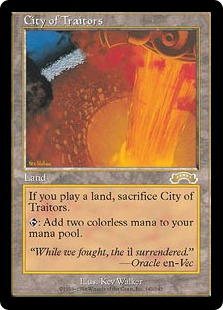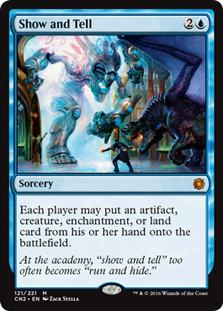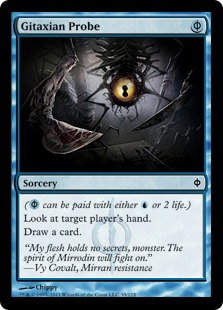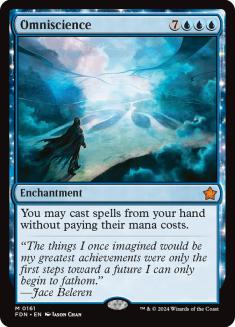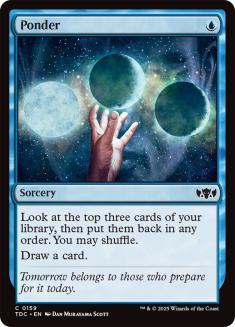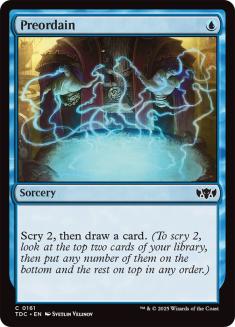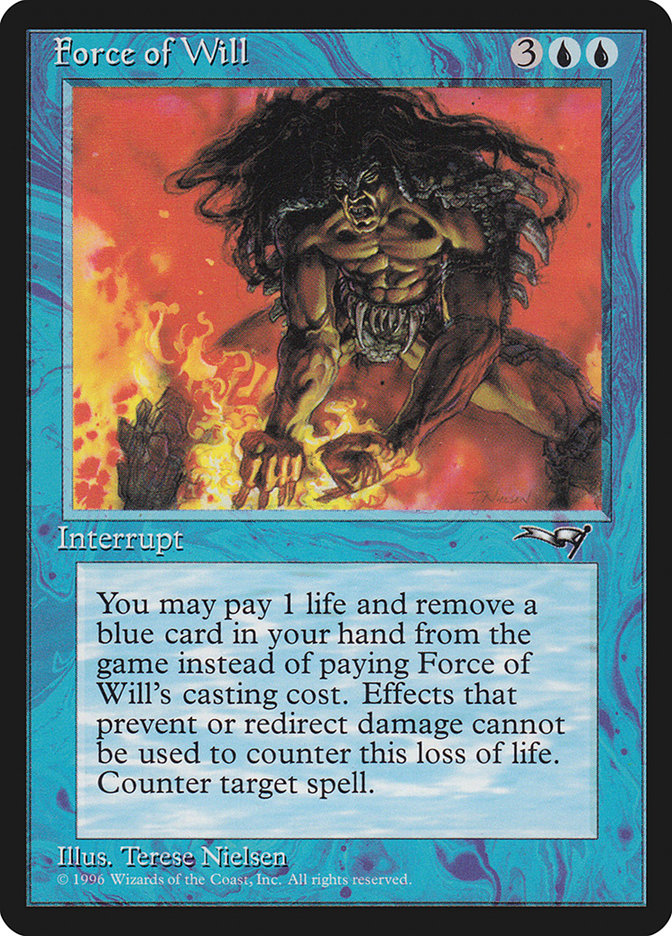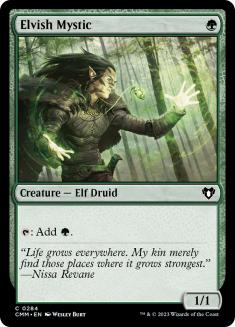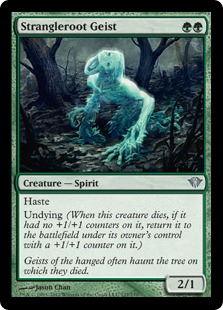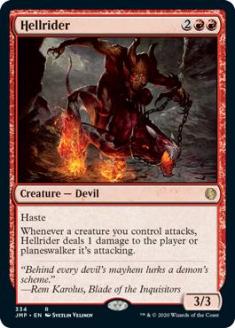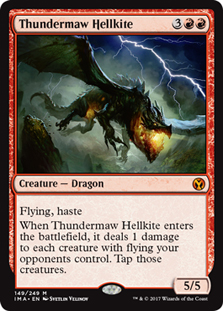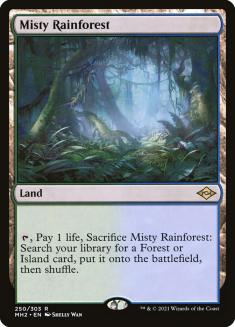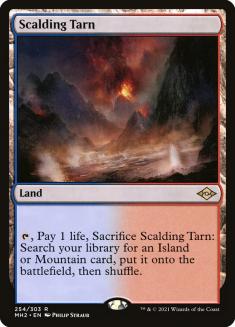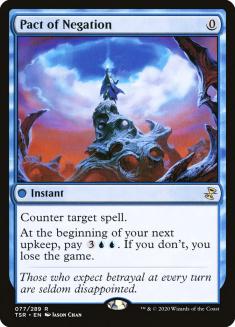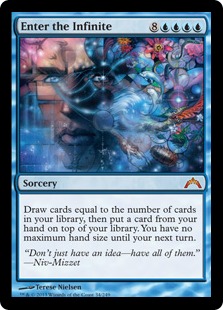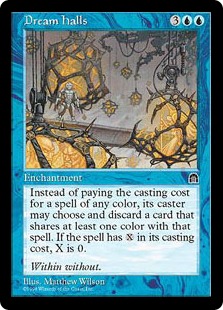You’re playing the following Omniscience list in the New Jersey Invitational.
Creatures (1)
Lands (20)
Spells (39)

You won game 1 against RUG Delver, so you’re on the draw for game 2. You fan out your seven cards. They are:
Do you keep? Why or why not? No generalizations, please. This is not an easy decision.
I kept it. The majority of my close friends would have mulliganed it. I think they are wrong. Here is why.
You have sixteen blue sources, one of which you will need to draw in the next four cards to play a game of Magic. You are a favorite to draw a blue source in your first two draws, however:
16 [blue sources] divided by 53 = 30.19%, the probability that you draw a blue source in your draw step on turn 1.
16 divided by 52 = 30.77%, the isolated probability that you draw a blue source off of the Gitaxian Probe. Events in Magic don’t exist in isolation, though, so the combined probability that we don’t draw a blue source that we can play as our first land is (100-30.19) x (100-30.77) = 48.32%—the probability that we miss on the second draw within a universe where we already missed on the first draw.
The upshot is that we’re betting on a slightly weighted coinflip to get to cast a cantrip on turn 1. But that’s not all we’re drawing to.
We also have three Defense Grids, which are solid gold against RUG Delver. They have to counter them or risk dying before turn 4. If we draw one in our first two draws, we can cast it off of City of Traitors. From there, we can wait for an Island to cast a Show and Tell that is protected by Grid.
Even if we miss on both draws, we still aren’t dead, as we can play City and wait for our 19/51 draws the following turn.
I did this exact math problem before I ever sat down at the Invitational, as I wanted to know if I could reasonably keep a Probe + City + Show and Tell hand on the draw. You see, mulliganing is awful in Legacy—even more so with Omniscience.
Why Mulliganing Is Awful In Legacy
Mulliganing isn’t always awful. There are strategic mulligans that fair decks can take to maximize their chances against unfair decks—mulliganing to Force of Will or Thalia, Guardian of Thraben against a combo deck, for instance. Dredge is a deck that uses the mulligan rule as a blue deck would use Ponder and Preordain. These are the exceptions to the rule.
The rule is that if you can play Magic with your opponent, it is probably wrong to mulligan.
What defines this rule? Only two of the most influential cards in the format:
Force of Will discourages mulligans on both sides of the table. If you have Force of Will in your deck, it’s miserable to draw a five- or six-card hand and see a card that makes you go down yet another card just to cast it.
If you’re playing against Force of Will, it is possible for your opponent to trade two of their cards for your best card. This means that mulliganing to your most powerful card is a poor gambit. When you mulligan, you rely more heavily on your best card having an outsized impact on the game state. Force of Will’s presence counteracts that strategic angle. It is better to have a hand full of mediocre cards that trade off than one card that’s a bomb and four that are blank.
Brainstorm is the other reason, and it is quite compelling. If you mulligan, Brainstorm is weaker. You will see fewer total cards in your deck and thus have access to fewer options. Brainstorm can entirely change a game plan, but it can only do so if you have the resources to trade in.
A common heuristic that I see players use when evaluating mulligan decisions is to ignore an uncastable card and consider their hand’s strength as a mulligan to six. Take Brian Kibler G/R Aggro deck as an example:
Creatures (29)
- 4 Arbor Elf
- 3 Scavenging Ooze
- 4 Strangleroot Geist
- 4 Hellrider
- 4 Thundermaw Hellkite
- 4 Flinthoof Boar
- 4 Ghor-Clan Rampager
- 2 Elvish Mystic
Planeswalkers (4)
Lands (24)
Spells (3)

If your opening seven is:
It is useful to set aside the Thundermaw Hellkite and ask yourself if you would keep the remaining six cards on their own, as the Thundermaw’s value is far less than a full card. It won’t reliably do anything to impact the game, so it can’t really count as a card in hand.
This doesn’t work in Legacy when you have blue cantrips, especially Brainstorm. That uncastable card might be blue and thus could fuel a Force of Will or could be one of two cards that you put back onto your deck with a Brainstorm. In economic terms, cards in hand are far more fungible in Legacy blue decks.
This is an easy concept to observe in matchups like the RUG Delver mirror. A player is a prohibitive favorite to win the game if their opponent mulligans to five, as the player with seven cards can trade off Stifles and Wastelands for lands, Dazes and Spell Pierces for spells, and Lightning Bolts and Spell Snares for creatures. Through careful Brainstorming and Pondering, they will end up ahead a land and a creature against an empty board and empty hand.
The concept is even more obvious in matchups where Omniscience has to fight through counters or discard.
Why Mulliganing Is Awful In Omniscience
Omniscience is a deck defined by its capacity to change game plans from turn to turn. You may think that the Dream Halls in your hand is nothing more than Force of Will fodder, but if you suddenly get flooded, your Omniscience may become Force fodder while Dream Halls turns into your best card and primary game plan.
The strength of this deck comes from its ability to shrug off resistance and disruption. The fourteen cantrips allow you to constantly reevaluate the value of various cards in your hand, revising your line of play to beat your opponent’s position.
If you mulligan, you rob yourself of options. You rob yourself of valuable cards to pitch to Force of Will. You rob yourself of blue cards to cast Enter the Infinite via Dream Halls. You create real vulnerability to Thoughtseize, Inquisition of Kozilek, and Liliana of the Veil. None of those cards matter until you’re down a card or two. If you have seven cards, it rarely matters what they take—they can’t Thoughtseize the top six cards of your deck.
If you mulligan, you have one less land to "trade" for RUG Delver’s Daze on a critical turn. You have one less card that could be a Pact of Negation against Spell Pierce or Pyroblast.
Mulliganing against a deck with a lot of discard is especially painful, as the game is not about racing in the traditional sense of the word but about the Omniscience player’s capacity to assemble a winning combination of spells before their hand gets torn apart. By shuffling a card away, you are likely giving your opponent an extra turn to draw yet another piece of disruption. It doesn’t matter how fast you kill them, only that you keep cards in your hand. There are points where it’s correct to not play a land since the card in hand is far more valuable than the land in play.
Many Omniscience players make the mistake of evaluating their game plan solely on the cards in their opening hand. Your hand may not look perfect at the beginning of the game, but you don’t play with all the cards in your opening hand. Some of them are going to get upgraded, others are going to get discarded, and the value of others will fluctuate wildly from turn to turn. You may think that this is a great opener:
And while I would definitely keep it, I would know that I’m not a favorite to win against a Thoughtseize, Inquisition of Kozilek, Cabal Therapy, or Vendilion Clique. You have no flexibility, nothing to do with extra lands, and your protection is strong against stack interaction but useless against permanents and sorceries.
My definition of "the nuts" with this deck is something closer to:
This hand has everything but speed. It has card selection in three cantrips, flood insurance in Dream Halls, a way to quickly upgrade if the top of the deck is very strong, and the ability to wait and have the game come to us if our opponent refuses to do anything. We can select the game plan that is most likely to beat our opponent, whereas the first hand hopes that our opponent is dead on turn 2. That plan isn’t bad, but it’s not as perfect as it looks.
Casting Cantrips
I just told you that having access to cantrips is powerful in many game states because cantrips give you options. They allow you to not draw cards that you would otherwise have to draw. They make Magic—a game played with randomized decks—meaningfully less random.
This deck abuses the power of cantrips by playing with cards that are all very powerful but which have wildly different power levels in different game states. The reason I emphasize this point is that I have watched a lot of players keep cards that won’t help them instead of putting them on the bottom with Preordain or shuffling them away with Ponder. I have watched players cantrip into cards that aren’t Show and Tell with hands that only need a Show and Tell. They Ponder, keep, and draw a protection spell that they may never need because they might never actually cast a meaningful spell in the game.
This advice may sound elementary, but don’t cantrip into cards that you don’t need. If you need an enchantment, shuffle away a second Show and Tell. If you need a Show and Tell, push every single card that isn’t a Show and Tell. This obvious-sounding advice has a corollary, which is that you should wait as long as possible to cast your most powerful cantrips.
If you have a hand with Preordain, Ponder, and Brainstorm, you should consider all of the following:
- Do I have a fetchland? If yes, I should wait to Ponder or Brainstorm until a turn where I can activate the fetchland immediately afterward.
- If I don’t have a fetchland, how much chaff does the rest of my hand contain? If there are redundant copies of various effects—multiple Omnisciences, too much protection, too many mana sources—then it is likely that you shouldn’t cast a cantrip on turn 1, cast Brainstorm on turn 2, and then Preordain both cards to the bottom if you don’t draw a fetchland.
- Is my game plan to cast Dream Halls? If yes, Brainstorm is more valuable, as having lands or Emrakul in your hand when you have Dream Halls is the same as not having those cards. In the context of Dream Halls, Brainstorm can figuratively draw you extra cards.
- You don’t want to Ponder as your first-turn cantrip unless you’re looking for exactly one card, as you have the least amount of information on turn 1. Furthermore, if you find the card you’re looking for next to two cards you aren’t interested in drawing, your turn 1 Ponder will force you to draw one of the undesirables. Better to have Preordained in that spot.
- Ponder can dig four cards deep, making it the best cantrip to cast once you know what you’re looking for. It is far better to use Ponder as a post-fetchland cantrip, as you will have the maximum amount of information from your other cantrips.
- Is my opponent playing Inquisition of Kozilek or Thoughtseize? If yes, do I have a card that I am very interested in protecting? If yes, it is likely that playing a slower game is superior: Brainstorm is useful not only as a way to shuffle bad cards away but as a way to hide good cards on top of your deck.
- What is the ideal configuration of my hand and on what turn can I maximize it? For instance, if your hand’s desired endgame is "cast Dream Halls," make sure that you’ve cast all of your cantrips before the turn where you want to put Dream Halls into play. Casting cantrips via Dream Halls is a poor strategy, one that should be saved for desperation situations only. If your hand’s desired endgame is "cast Show and Tell with multiple counter backup, put in Omniscience, and cast Enter the Infinite," then it makes a ton of sense to cantrip aggressively in the first few turns to look for more Force of Wills and Pact of Negations.
This deck has access to a tremendous amount of card filtering, and it is important to understand your game plan when you’re casting your Ponders and Preordains. It is even more important to understand that your game plan can change on any turn with newfound access to key cards. Don’t lock yourself into one paradigm—this deck can win in a number of different ways. If you count Cunning Wish as a card selection spell, this deck plays seventeen cards that allow you to draw more cards and gain valuable information.
Casting Cunning Wish
Cunning Wish is a key element of the deck. At its most basic level, it finds Release the Ants from the sideboard to kill an opponent after casting Enter the Infinite. Its utility far exceeds that role. It can be used as a six-mana Demonic Tutor in conjunction with the sideboarded Intuition, finding either enchantment, Show and Tell, or Enter the Infinite. It can find the right anti-hate spell from the sideboard, whether it’s Sapphire Charm for Ethersworn Canonist / Gaddock Teeg; Slaughter Pact for Thalia, Guardian of Thraben; or Rushing River for a combination of the two.
One of its more important uses is against cards like Detention Sphere where it can be cast via Omniscience to find Trickbind, which counters the triggered ability of a permanent-based hate card. However, its most common use is more proactive.
Most of the times that you cast Cunning Wish prior to casting Enter the Infinite, it will be to find Pact of Negation. This additional layer of protection often makes the difference between winning and losing the counter war over Show and Tell.
The previous two paragraphs lay out the fundamental tension surrounding Cunning Wish. If you cast it on their end step and find Pact of Negation, you’re giving up your line of protection against Venser, Shaper Savant; Vendilion Clique; Detention Sphere; and Meddling Mage. If you don’t cast it on their end step, you might lose the fight over getting your enchantment into play.
This tension is where the true value of Gitaxian Probe comes in. Although the two Probes are the weakest cards in the deck, they are more than just Street Wraiths. They can be cast on turn 1, but they do not have to be. It is enormously valuable to Probe an opponent on a turn where you can kill them but do not have to, as the information that Probe provides will allow you to find the exact tools you need to beat their hand. In this way, Gitaxian Probe informs the optimal use of Cunning Wish, which is an interaction worth remembering.
If you would like to read an article dedicated more to the ways in which this decklist came into being, my deck tech article on Omni-Tell can be found here. If you would like to see the deck in action, come back next week for a video of me playing the deck in a Legacy Daily Event on Magic Online!
If you have any questions, I’d be happy to chat with you in the comments section or on Twitter.
Until next week,
@drewlevin on Twitter

